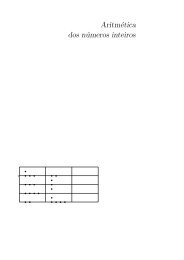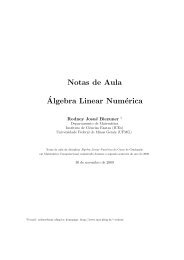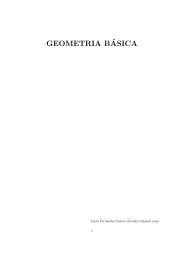- Page 1:
Algoritmos e complexidade Notas de
- Page 4 and 5:
Conteúdo 5. Programação dinâmic
- Page 6 and 7:
Conteúdo 15.Complexidade de circui
- Page 9:
Parte I. Análise de algoritmos 7
- Page 12 and 13:
1. Introdução e conceitos básico
- Page 14 and 15:
1. Introdução e conceitos básico
- Page 16 and 17:
1. Introdução e conceitos básico
- Page 18 and 19:
1. Introdução e conceitos básico
- Page 20 and 21:
1. Introdução e conceitos básico
- Page 22 and 23:
1. Introdução e conceitos básico
- Page 24 and 25:
1. Introdução e conceitos básico
- Page 26 and 27:
1. Introdução e conceitos básico
- Page 28 and 29:
1. Introdução e conceitos básico
- Page 30 and 31:
1. Introdução e conceitos básico
- Page 32 and 33:
1. Introdução e conceitos básico
- Page 34 and 35:
2. Análise de complexidade • Par
- Page 36 and 37:
2. Análise de complexidade • Uma
- Page 38 and 39:
2. Análise de complexidade 1. Atri
- Page 40 and 41:
2. Análise de complexidade Exemplo
- Page 42 and 43:
2. Análise de complexidade Compone
- Page 44 and 45:
2. Análise de complexidade • Qua
- Page 46 and 47:
2. Análise de complexidade Algorit
- Page 48 and 49:
2. Análise de complexidade Algorit
- Page 50 and 51:
2. Análise de complexidade Tratabi
- Page 52 and 53:
2. Análise de complexidade A compl
- Page 54 and 55: 2. Análise de complexidade • Fre
- Page 56 and 57: 2. Análise de complexidade Exemplo
- Page 58 and 59: 2. Análise de complexidade 1 i f l
- Page 60 and 61: 2. Análise de complexidade Novamen
- Page 62 and 63: 2. Análise de complexidade Logo te
- Page 64 and 65: 2. Análise de complexidade 7 for c
- Page 66 and 67: 2. Análise de complexidade Com iss
- Page 68 and 69: 2. Análise de complexidade funçã
- Page 70 and 71: 2. Análise de complexidade Algorit
- Page 72 and 73: 2. Análise de complexidade resolve
- Page 75: 3. Introdução Resolver problemas
- Page 78 and 79: 4. Algoritmos gulosos A abordagem g
- Page 80 and 81: 4. Algoritmos gulosos Do outro lado
- Page 82 and 83: 4. Algoritmos gulosos Aplicações
- Page 84 and 85: 4. Algoritmos gulosos 1 V ′ := {v
- Page 86 and 87: 4. Algoritmos gulosos Algoritmo de
- Page 88 and 89: 4. Algoritmos gulosos Implementaç
- Page 90 and 91: 4. Algoritmos gulosos Variação do
- Page 92 and 93: 4. Algoritmos gulosos • Como comp
- Page 94 and 95: 4. Algoritmos gulosos Proposição
- Page 96 and 97: 4. Algoritmos gulosos Resultados O
- Page 98 and 99: 5. Programação dinâmica É simpl
- Page 100 and 101: 5. Programação dinâmica soluçã
- Page 102 and 103: 5. Programação dinâmica Teorema:
- Page 106 and 107: 5. Programação dinâmica 5.2.2. S
- Page 108 and 109: 5. Programação dinâmica 11 sol1
- Page 110 and 111: 5. Programação dinâmica O algori
- Page 112 and 113: 5. Programação dinâmica Dependen
- Page 114 and 115: 5. Programação dinâmica Análise
- Page 116 and 117: 5. Programação dinâmica curto do
- Page 118 and 119: 5. Programação dinâmica Logo, po
- Page 120 and 121: 5. Programação dinâmica (começa
- Page 122 and 123: 5. Programação dinâmica Árvore
- Page 125 and 126: 6. Divisão e conquista 6.1. Introd
- Page 127 and 128: Recorrências simplificadas Formalm
- Page 129 and 130: 6.2. Resolver recorrências • Usa
- Page 131 and 132: 6.2. Resolver recorrências Para co
- Page 133 and 134: 6.2. Resolver recorrências O algor
- Page 135 and 136: • Prove por indução que T (n) =
- Page 137 and 138: Saída A potência a n . 1 i f n =
- Page 139 and 140: 3 Quicksort (l ,m − 1 ,a ) ; 4 Qu
- Page 141 and 142: 6.2. Resolver recorrências 1. Se f
- Page 143 and 144: 6.3. Algoritmos usando divisão e c
- Page 145 and 146: 6.3. Algoritmos usando divisão e c
- Page 147 and 148: 6.3. Algoritmos usando divisão e c
- Page 149 and 150: 6.3. Algoritmos usando divisão e c
- Page 151 and 152: unidade. Em total a avaliação pro
- Page 153: 3. T (n) = 3T (n/4) + n log n 4. T
- Page 156 and 157:
7. Árvores de busca, backtracking
- Page 158 and 159:
7. Árvores de busca, backtracking
- Page 160 and 161:
7. Árvores de busca, backtracking
- Page 162 and 163:
7. Árvores de busca, backtracking
- Page 164 and 165:
7. Árvores de busca, backtracking
- Page 166 and 167:
7. Árvores de busca, backtracking
- Page 168 and 169:
7. Árvores de busca, backtracking
- Page 170 and 171:
7. Árvores de busca, backtracking
- Page 172 and 173:
7. Árvores de busca, backtracking
- Page 174 and 175:
7. Árvores de busca, backtracking
- Page 176 and 177:
7. Árvores de busca, backtracking
- Page 178 and 179:
7. Árvores de busca, backtracking
- Page 180 and 181:
8. Algoritmos de aproximação Clas
- Page 182 and 183:
8. Algoritmos de aproximação Exem
- Page 184 and 185:
8. Algoritmos de aproximação - Te
- Page 186 and 187:
8. Algoritmos de aproximação O qu
- Page 188 and 189:
8. Algoritmos de aproximação Como
- Page 190 and 191:
8. Algoritmos de aproximação decr
- Page 192 and 193:
8. Algoritmos de aproximação •
- Page 194 and 195:
8. Algoritmos de aproximação Apro
- Page 196 and 197:
8. Algoritmos de aproximação 12(l
- Page 199 and 200:
9. Algoritmos em grafos 197
- Page 201 and 202:
9.1. Fluxos em redes A circulação
- Page 203 and 204:
+ + − + Figura 9.3.: Manter a con
- Page 205 and 206:
Prova. Seja f um fluxo s-t. Temos 9
- Page 207 and 208:
9.1. Fluxos em redes aumentou nessa
- Page 209 and 210:
9.1. Fluxos em redes Figura 9.5.: R
- Page 211 and 212:
V ′ = V ∪ {s ∗ , t ∗ } 9.1.
- Page 213 and 214:
s 30 19 12 i 10 10 j 10 10 10 1010
- Page 215 and 216:
Solução Um fluxo s-t f com valor
- Page 217 and 218:
Objetivo Minimiza o valor c(M) de M
- Page 219 and 220:
9.2. Emparelhamentos Teorema 9.4 (B
- Page 221 and 222:
9.2. Emparelhamentos V1 e V2 com fl
- Page 223 and 224:
9.2. Emparelhamentos não sabemos c
- Page 225 and 226:
9.2. Emparelhamentos Sobre a implem
- Page 227 and 228:
9.2. Emparelhamentos reduzir o prob
- Page 229 and 230:
v10 v9 v1 v8 v2 v3 v7 v6 v4 v5 v10
- Page 231 and 232:
10. Algoritmos de aproximação (As
- Page 233 and 234:
2 2 10.2. Aproximações para o PCV
- Page 235 and 236:
10.3. Algoritmos de aproximação p
- Page 237 and 238:
10.3. Algoritmos de aproximação p
- Page 239:
Parte IV. Teoria de complexidade 23
- Page 242 and 243:
11. Do algoritmo ao problema Modelo
- Page 244 and 245:
11. Do algoritmo ao problema - entr
- Page 246 and 247:
11. Do algoritmo ao problema Lingua
- Page 248 and 249:
11. Do algoritmo ao problema Observ
- Page 250 and 251:
11. Do algoritmo ao problema Decibi
- Page 253 and 254:
12. Classes de complexidade 12.1. D
- Page 255 and 256:
12.2. Hierarquias básicas Prova. (
- Page 257 and 258:
12.2. Hierarquias básicas 1. Temos
- Page 259:
12.3. Exercícios 12.3. Exercícios
- Page 262 and 263:
13. Teoria de NP-completude • Int
- Page 264 and 265:
13. Teoria de NP-completude C-≤-d
- Page 266 and 267:
13. Teoria de NP-completude Ladrilh
- Page 268 and 269:
13. Teoria de NP-completude (q, a)
- Page 270 and 271:
13. Teoria de NP-completude Sejam c
- Page 272 and 273:
13. Teoria de NP-completude Decisã
- Page 275 and 276:
14. Fora do NP Classes fora do P-NP
- Page 277 and 278:
A classe co-NP 14.1. De P até PSPA
- Page 279 and 280:
14.1. De P até PSPACE Para provar
- Page 281 and 282:
A hierarquia polinomial Mais exempl
- Page 283 and 284:
• Agora, consideramos os seguinte
- Page 285:
14.3. Exercícios The equivalence p
- Page 288 and 289:
15. Complexidade de circuitos x1 ¬
- Page 290 and 291:
15. Complexidade de circuitos Corol
- Page 292 and 293:
15. Complexidade de circuitos Teore
- Page 295 and 296:
A. Conceitos matemáticos Nessa se
- Page 297 and 298:
Proposição A.3 (Regras para pisos
- Page 299 and 300:
2 1 0 0 1 2 3 4 5 6 7 8 9 10 A.1. F
- Page 301 and 302:
A.2. Somatório A última regra é
- Page 303 and 304:
Uma aplicação: 1≤i≤n ix i =
- Page 305 and 306:
Lema A.1 (Definição alternativa d
- Page 307:
A.6. Grafos e ∩ f = ∅. Para um
- Page 310 and 311:
B. Soluções dos exercícios Prova
- Page 312 and 313:
B. Soluções dos exercícios Prova
- Page 314 and 315:
B. Soluções dos exercícios 6. n
- Page 316 and 317:
B. Soluções dos exercícios c fix
- Page 318 and 319:
B. Soluções dos exercícios 9 ret
- Page 320 and 321:
B. Soluções dos exercícios Anali
- Page 323 and 324:
Índice DSPACE, 252 DTIME, 252 NP,
- Page 325 and 326:
função concava, 297 convexa, 297
- Page 327:
teorema de Savitch, 256 tese de Cob
- Page 330 and 331:
Bibliografia [15] Thomas H. Cormen
- Page 332 and 333:
Bibliografia [42] Jon Kleinberg e
- Page 334:
Bibliografia [72] V. Vassilevska Wi









